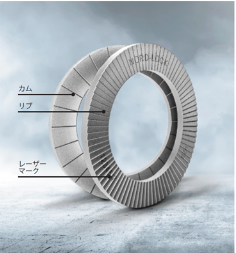What Is a Nord-Lock Washer?

Nord-lock washers are two-piece washers with an anti-looseness feature, invented by Nord-lock in 1982.
Nord-lock washers come in pairs, with the cam surfaces (see above) facing each other so that the ribs grip the bolt/nut and the mating material. The Nord-lock washers are used to grip the threaded nut and mating material.
Nord-lock washers are effective against screw loosening, but only against rotational loosening. Besides rotational looseness, non-rotational looseness is another type of screw looseness. Non-rotational looseness is caused by plastic deformation of the member sandwiched by the screw.
Uses of Nord-Lock Washers
Nord-lock washers are used in screw fastening where rotational loosening is not allowed. They are therefore used in specific areas in a variety of fields. They are used in buildings, power equipment, railroads, and other transportation systems, as well as various types of equipment.
Examples include cable bands for suspension bridges and steel-frame bridges in the building industry. In the electric power industry, they are used in turbine rotors for wind power generation, reactor pressure vessels for nuclear power plants, converters for tidal power generation, and coupling devices for railroad cars.
Principle of Nord-Lock Washers
1. When Closing the Bolt/Nut
The function of a bolt is often compared to that of a spring. The bolt is stretched as it is tightened, and the simultaneous undo force (axial force) grips the object being fastened.
Unlike other anti-looseness products, the Nord-lock washer uses the axial force itself, not friction, to prevent the bolt/nut from returning to its original position. When the bolt or nut is tightened using the Nord-lock washer, the cams engage each other and the two sets of outer ribs grip the bolt/nut and the mating material surface to hold it in place.
This grip mark is left as an impression mark on both the bolt/nut and the mating material and is proof that the anti-looseness effect is working. When a loosening force is applied, the inner cams slide together. The cam angle α is designed to be larger than the thread lead angle β. When the cams move, the washer thickness increases, and pulls the bolt head up.
This wedge-locking technology physically prevents the bolt from loosening even when exposed to severe vibration.
2. To Loosen a Bolt/Nut
When loosening the bolt/nut, the Nord-lock washer is secured between the bolt/nut and the mating material by the ribs, so only the area between the cams inside the two-piece set slides, and the washer on the mating material side does not move. The axial force increases as the bolt head is pulled up until the cam overcomes one of the mating cams, but once the cam overcomes the mating cam, the wedge lock is released and the bolt can be removed.
The Nord-Lock is designed to allow removal with less than the tightening torque.
Other Information on Nord-Lock Washers
1. Nord-Lock Washer Material
Depending on the application, Nord-lock washers are made not only of regular iron (steel, Delta Protect coated) and stainless steel (SUS316L equivalent), but also of super stainless steel, a highly corrosion resistant stainless steel called 254SMO® (SUS312L equivalent), Alloy C276 (Hastelloy C-276 equivalent), Alloy718 Alloy C276 (Hastelloy C-276 equivalent) and Alloy718 (Inconel 718 equivalent).
2. Reuse of Nord-Lock Washers
Nord-lock washers are reusable. The first time they are used, the two pairs of washers are glued together. After the glue is removed for reuse, the washers should be placed on top of each other so that the cam surfaces (large-jagged surfaces) are in contact with each other. The number of times they can be reused depends on the conditions of use and other factors.
3. Tightening Torque for Nord-Lock Washer
The tightening torque for fastening with Nord-lock washers is determined by the required axial force of each user, which is no different from that of general fastening. On top of that, manufacturers have prepared torque guidelines for determining torque and applications for automatic Nord-lock tightening torque calculations.